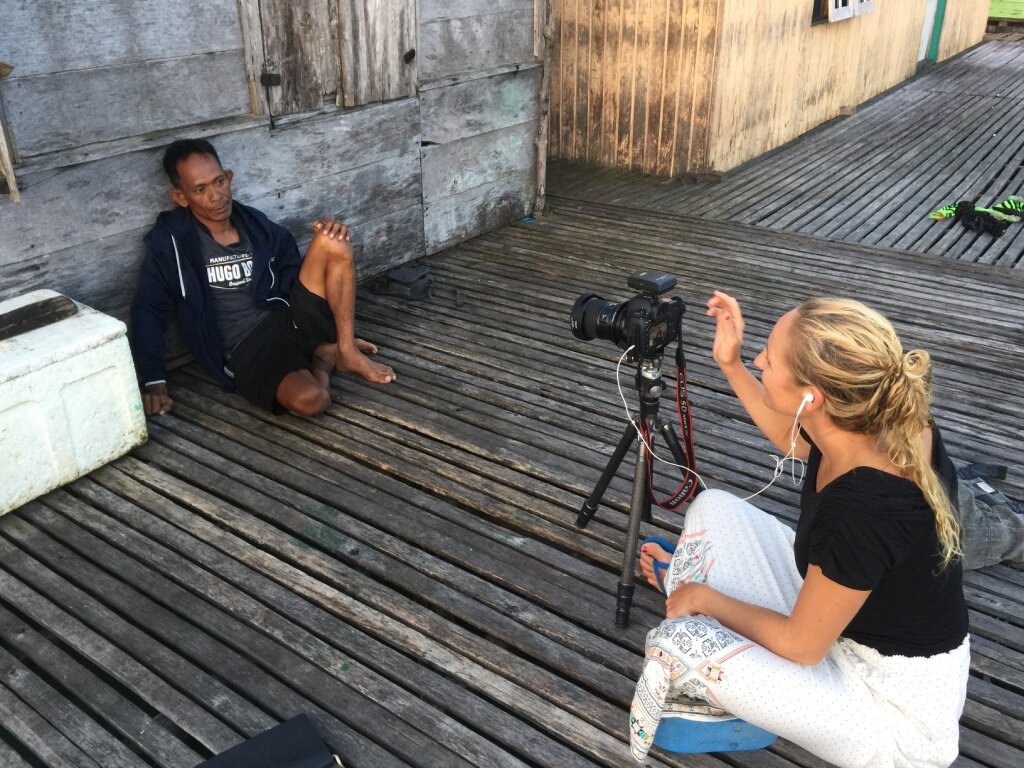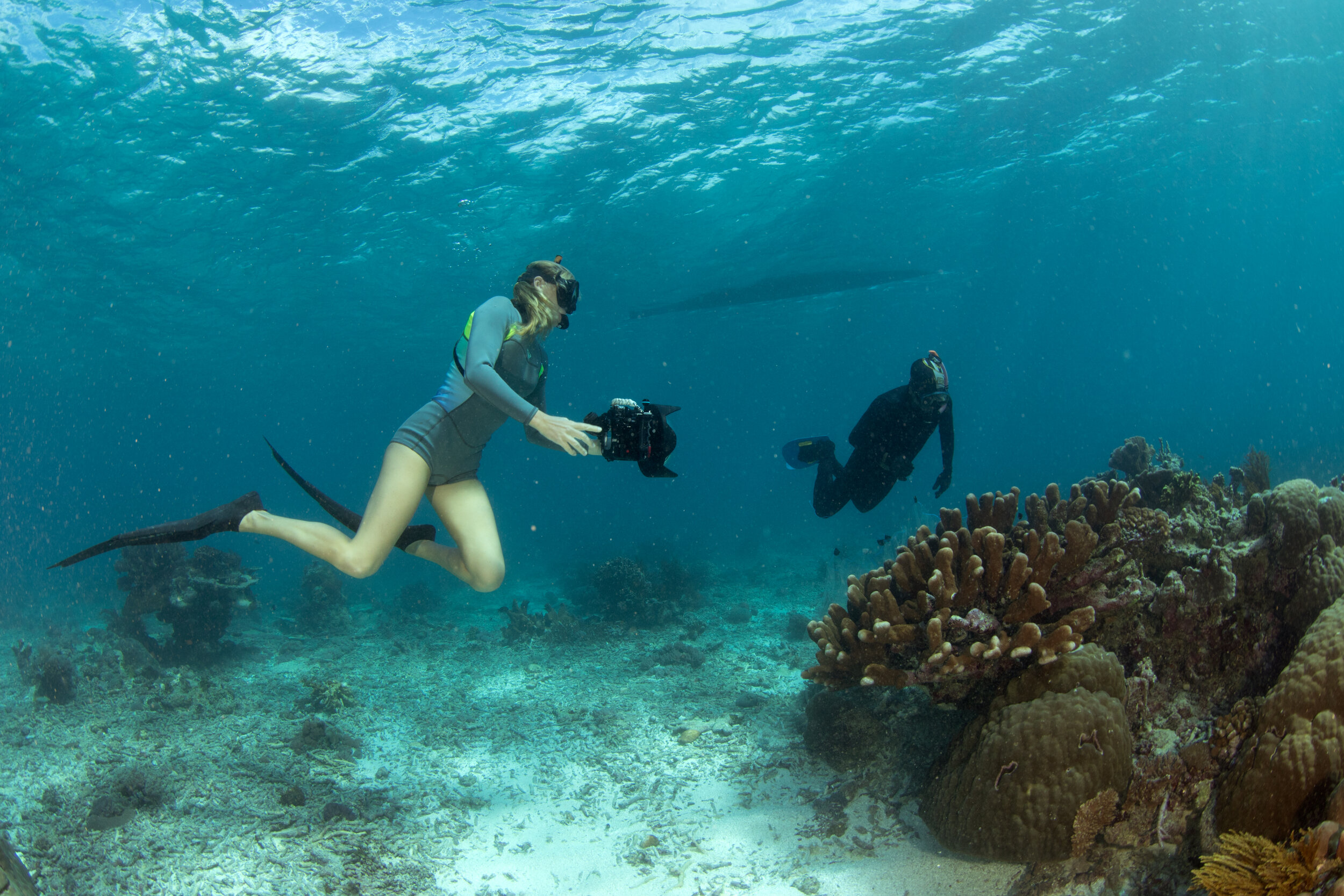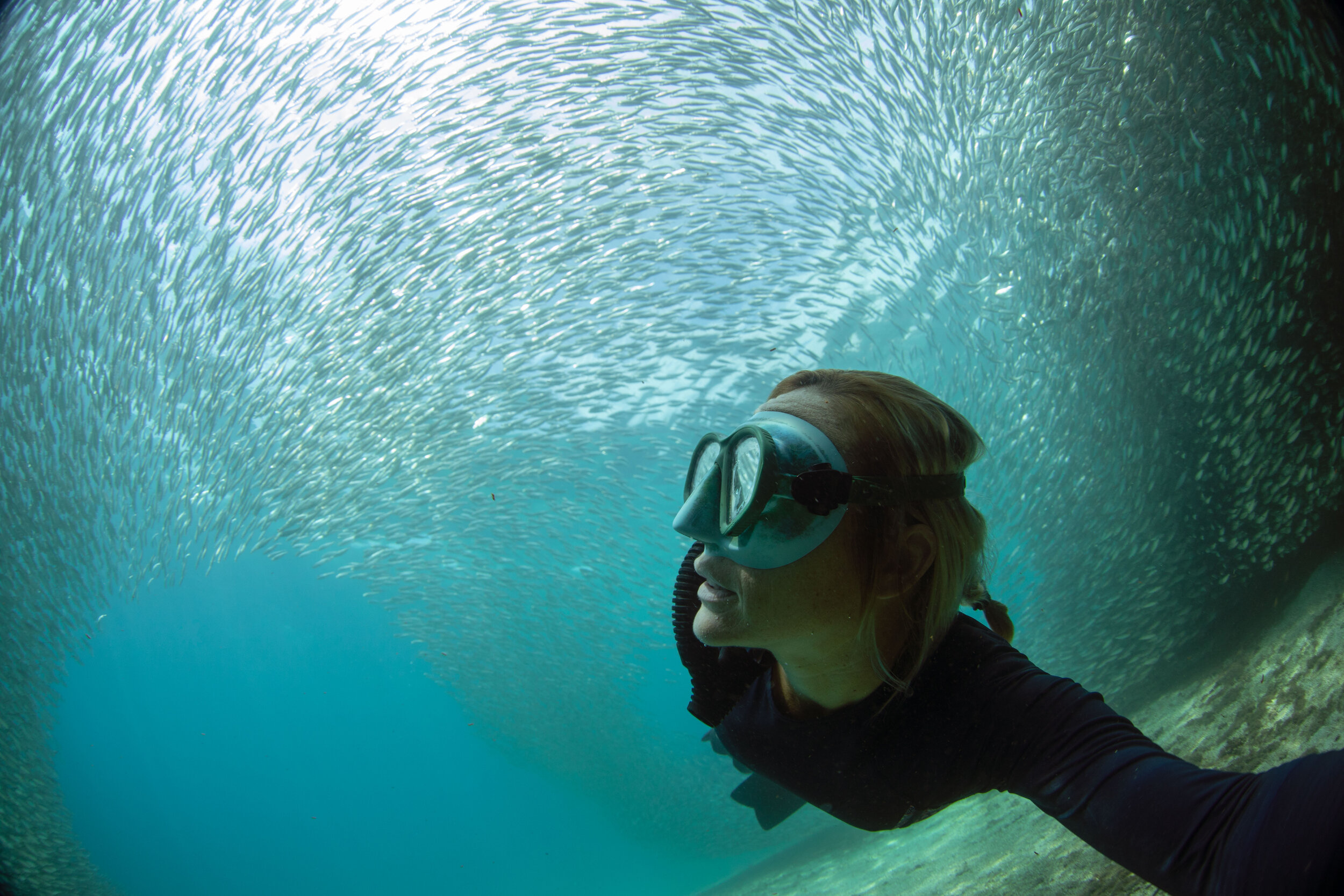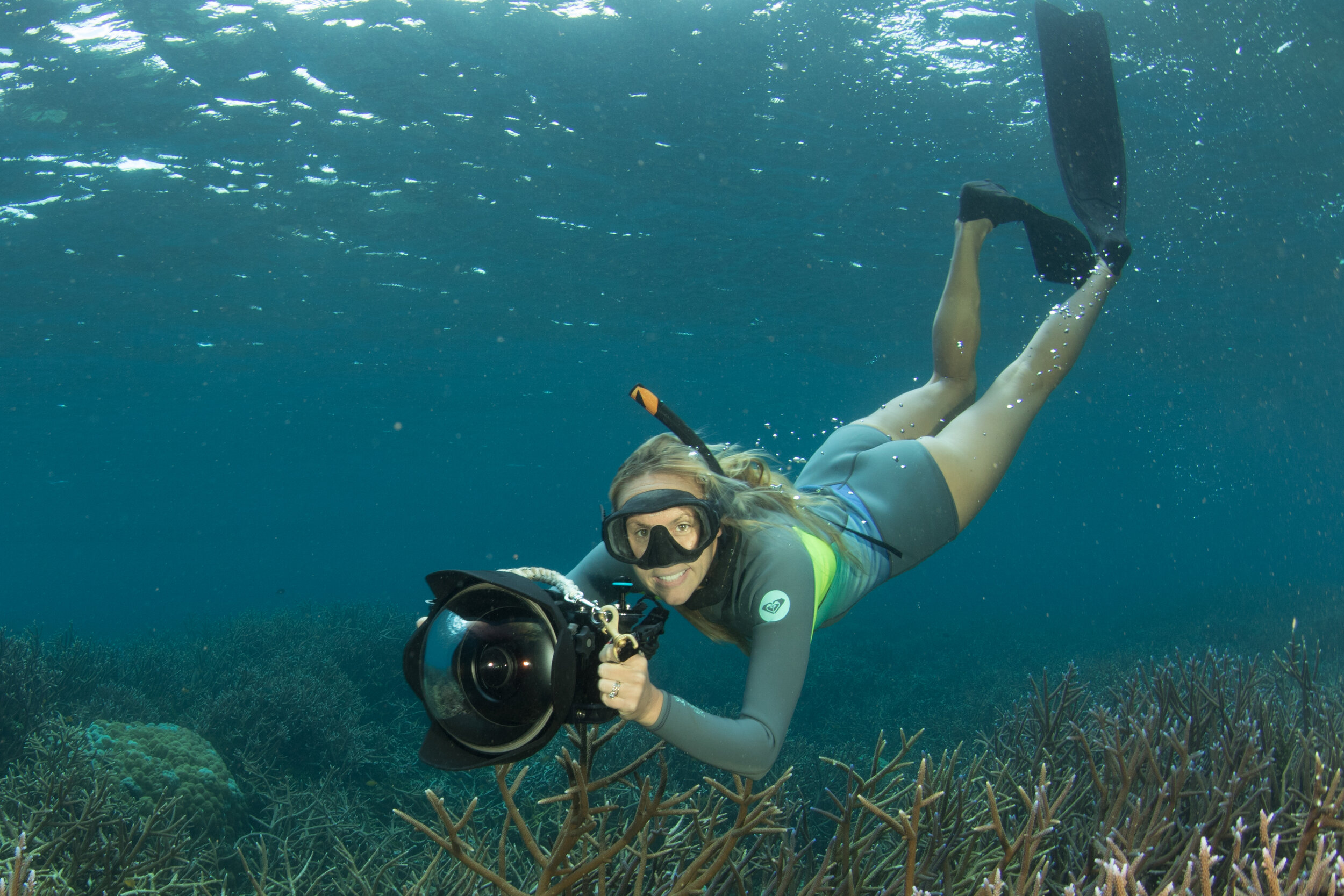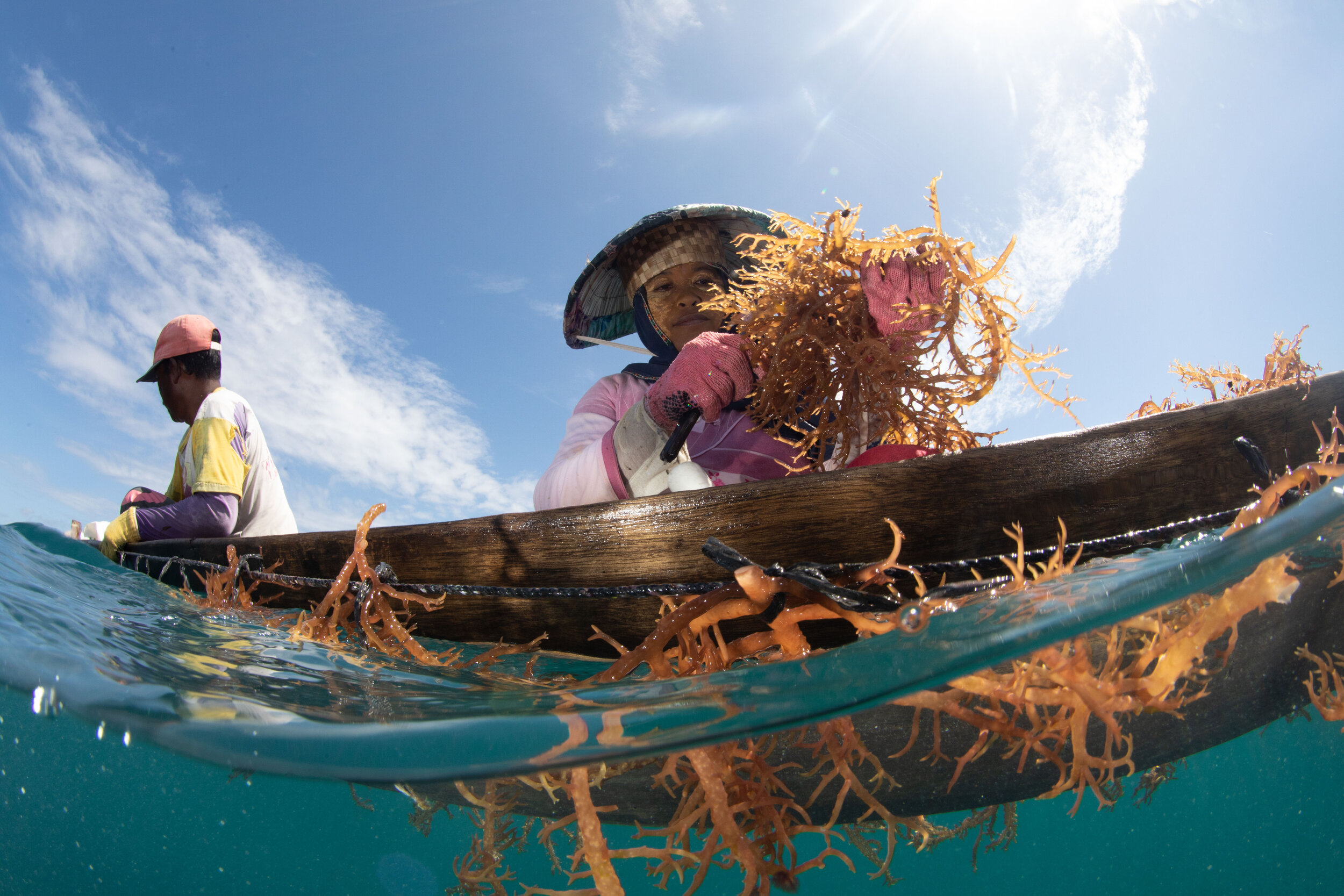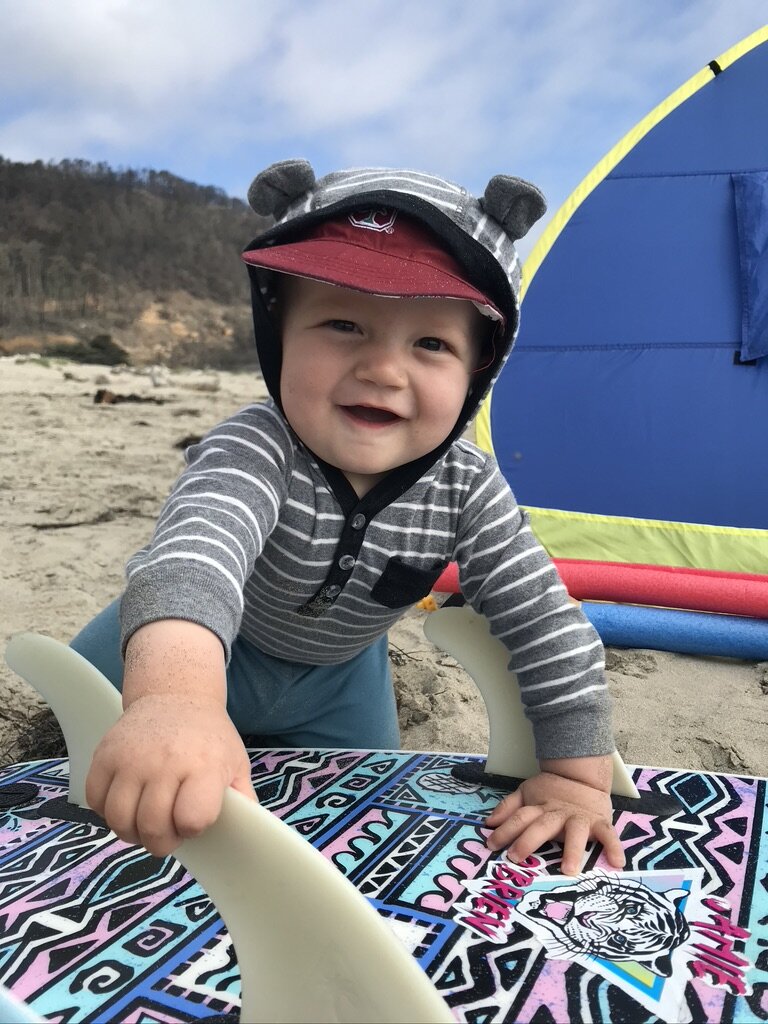Featured Shero: Shannon Switzer Swanson
Interview by Captain Liz Clark
Please welcome our Featured Shero, Shannon Switzer Swanson, who has dedicated her life to bettering this planet, herself & those around her. Shannon is a marine social ecologist, surfer, photographer, mom & amazing all around water woman from San Diego, California who uses a blend of anthropology, psychology & ecology to address today’s most pressing marine conservation issues. She has traveled the globe researching, listening & learning from locals, & logging in some solid ocean time, above & below. Shannon sat down with our very own Captain Liz Clark to catch up & share her story.
Photo: Liz Clark
It’s been a while since we caught up! How are you, sister? Where are you these days?
It is such a treat to be able to connect with you. I have been great, exhausted since our little boy arrived last November, but great! For the last six years—minus the year that I was based in Indonesia for my PhD research—I have been living on Stanford’s idyllic campus in the Bay Area.
During our epic sailing trip aboard, Swell, in 2006, where you were my first mate all the way from San Diego to Costa Rica, I remember we read Rachel Carson’s “The Sea Around Us” together & dreamed of saving the planet. Since then you have used such an amazing blend of your diverse creative, scientific, & athletic skills to accomplish so much for our oceans! Can you give us a little recap of your favorite projects & accomplishments over the last decade or so….?
Joining you on your trip really showed me a different way to engage with diverse ecosystems and cultures; it altered & propelled my life’s course in so many incredible ways for which I’m forever grateful! After our time together I delved into conservation photography, began building a portfolio, then spent six months in the Seychelles studying & documenting whale shark & cetacean behavior, followed by six months in Uganda studying chimpanzee behavior as well as disease transfer between humans & chimps (all funded by waitressing tips!)
After this time in the field sharpening both my research & storytelling skills, I returned to Santa Barbara just a little over three years after graduating from UCSB (go Gauchos!) to write & photograph for a stint at the SB Independent weekly newspaper as well as work for a documentary production company. During this time, I also assisted National Geographic underwater photographer, Thomas Peschak, on one of his assignments in the Yucatan, which is how I came to learn about their grant program.
I applied for one of their Young Explorer grants proposing to document the watershed in San Diego County (where we both grew up!) & how pollution on land impacts coastal & ultimately human health. This project led to several athletic endeavors, including trekking along the San Dieguito River from headwaters to rivermouth, camping & photographing pollutants along the way, as well as stand-up paddling ~70 miles from Trestles to the Tijuana River to raise money for coastal conservation initiatives in San Diego.
More importantly the project cemented my love for storytelling while also helping me realize that I was craving new knowledge. So, after a seven-year hiatus, I decided to return to school to develop an area of expertise & contribute to how we understand human-ocean connections. Since returning to school (first a masters at Duke & now the PhD), I’ve been working with coastal fishing communities in the Philippines & Indonesia to understand how fishing families, non-governmental organizations, & government agencies can work together in a just, equitable, & effective manner to care for marine spaces in ways that honor the deep connections people in each of those groups often have with the sea.
Photos: Garth Cripps, Read Miller
Please tell us more about your time with the Bajau people of Southeast Asia! Did you find it difficult to meet the scientific demands of your mission while in a totally new environment & culture, where there is so much daily adventure & unknown?
My time with the Sama Bajau & the other indigenous people groups in the Banggai Archipelago (which is in Central Sulawesi, Indonesia) was humbling, mind- and soul- stretching, & a true trial by fire of sorts. I was attempting to use a participatory research approach, called photovoice, that incorporates community photography with the aim of rebalancing researcher-participant power dynamics & making space for participants to have more ownership over the process. Employing these methods really reshaped my understanding of what true ownership & meaningful participation look like.
For example, I was initially interested in understanding why some fishers use what conservationists term “destructive practices” like cyanide & blast fishing, & while I learned a great deal about this, I also came to understand that it is such a small part of the innerworkings of those individuals, families, & communities, and that in most cases they found other concerns & issues much more relevant to their lived experience. So I felt torn in a way, between numerous goals, especially while wanting my work to be helpful in some way to the very people investing so much time in it and in me. I am especially cognizant of this as a white western outsider working with rural communities in the global south. Working with humility and flexibility is something I am always striving to do better.
More practically, it was very challenging keeping up with all my field notes—I still have books & books full of research notes that I have yet to type up & organize from my time in Indonesia. This was due to unreliable electricity but also the miles & miles of stunning reefs that called to me to explore them each day. I swam the reef so often that I came to know the particular hidey-holes preferred by specific moray eels, the crevice in the reef preferred by a giant resident lionfish, & the very deep edge of the reef where the same hawksbill would timidly visit every now & again. It was such a privilege to get to know the inhabitants of those reefs—both human & non-human.
Photos: Garth Cripps, Shannon Swanson
It takes a lot of social skill to be accepted into foreign communities to do this kind of research you are doing, how much of what you do depends on your ability to create positive relationships in the places you go? What is your approach?
Yes, absolutely! I remember when we were on the boat together, & you were always thinking ahead and bringing things on the boat that you anticipated people who we encountered along the way might need or want. Not as a bribe or barter but as a signal of good will & in a spirit of communal giving & generosity. That definitely stuck with me & is one of the reasons why it was is important to me now to do research that is participatory & action-oriented. Using the method of photovoice meant I was able to print photo albums for each participant so that at the end of the project they had something tangible that, though small, was meaningful to them. Additionally, whenever I could, I would run errands for the fishing families in the remote islands while I was on the main island of Banggai, or for inhabitants of Banggai, when I traveled to or from mainland Central Sulawesi—places they do not have the means to travel to often. Also, just taking the time to be with people & really listen with openness & no judgement goes a long way. I know the people I interacted with appreciated that, especially in more personal contexts, like when the mom’s I lived with shared their experiences of loneliness, or the pressure of providing for their children, etc. It’s such a privilege to get to be a part of people lives in this way, especially in a sociocultural context that is so different from my own.
Photo Courtesy: Shannon Swanson
Your scientific adventures must not be without some moments of fear, self-doubt, & discomfort … How do you push through those moments? Were you born courageous, or is it something you think we can develop?
That’s the nature of moving out of your comfort zone, to which you can mightily attest! One of the scariest moments during my field research in Indonesia was in one of the remote islands when there was a large earthquake, & suddenly everyone was terrified of a tsunami hitting (this was just after the massive tsunami in Palu in 2018 that killed over 2,000 people). We had no way of getting news of what was going on—the magnitude of the quake, the epicenter, if there was a tsunami warning, etc.—and everyone was scrambling to gather their possessions, food and water. It was the first time I’d felt terrified during my time there. I kept thinking, man, everyone here has their families but me. It was one of many times that year I resolved this would be my last long stint without my loved ones.
Anyway, what helped me that night & what has always helped me was remembering that I’m a part of something much bigger than my individual life—which for me means talking to my Creator & remembering my connection to creation. That night this meant praying & reflecting on my life to date. Mama Yadi, who I was staying with was also praying & singing to her Creator, and in that moment it was so clear that although I’m Christian & she’s Muslim, we were praying to the same entity. While I’ll never know exactly what she was thinking in those moments, for me praying & reflecting gave me comfort knowing that if I died that night, I knew I had done my best to love & serve our Creator, Mother Earth, and the people in my life. It was a few hours of quiet affirmation that, if we made it past that night (which we obviously did, lol), I must continue to learn how to love & serve better & better.
But I don’t think people are born courageous, I think it’s absolutely something we can all develop bit by bit. And every day presents opportunities to be courageous. I think those people you hear about on TV who risk their life to rescue someone or decide to sail around the world, did small courageous things every day leading up to that point to prepare them for that moment or event—like speaking up in an awkward situation on behalf of someone who might not even be present, or being willing to address one’s own past hurt or trauma in order to heal & not pass on that trauma, or for the fishermen I worked with, going out to fish everyday even though they knew it most likely wouldn’t cover all of their family’s expenses but still trying anyway. That is everyday courage, & we can all develop it.
Photos: Garth Cripps, Shannon Swanson
I know that part of your interest in the human – ocean interaction & connection started from surfing in polluted water in Oceanside. Since then, you have studied such a wide variety of human relationships with the sea. I’m wondering if you’ve had any big ah- ha moments, that really shifted your thinking about humanity’s relationship to the ocean?
It’s so fascinating to me how people can develop such a constellation of relationships with the ocean. It’s like the ocean is both a mirror & a transformative power, meeting you where you are & then working on your soul & giving it what it needs. I’ve always loved the ocean for how it gives me space to think, to exercise, to experience the beyond-human. After spending time with the fishing families who in some cases literally live above the ocean in stilt houses, they have a whole other way of being with the sea. The tide & swell dictates everything they do, as does the weather. They have intimate knowledge of the reef & mangrove inhabitants as well as pelagic creatures swimming in the deep ocean & what moon cycle brings them around or leads them to spawn. They also know the ocean to be calm & monotonous with occasional moments of terrifying violence, which reflects their own days at sea, sitting, waiting, waiting, then bam spearing an octopus or a giant sting ray & bashing their heads to finish them quickly. I don’t mean to be graphic but honest. They know how nearly everything they see swimming, crawling, or growing in the ocean smells & tastes. They literally depend on it to survive. They know the ocean in a way that I never will, even if I lived with them & learned from them the rest of my life.
From all of my time studying these dynamic human-ocean connections, I can’t really pinpoint any ah-ha moments, at least none are coming to mind right now. However, cumulatively it all points back to having a humility & a respect for the systems that support us & engaging in acts of reciprocity with them, even if across the world that looks different.
I remember you being happiest when you saw a big shark, or just got out of the ocean after surfing enormous waves, do you still have a sweet spot for adrenaline?
It’s funny, I never thought of myself as an adrenaline junkie, though I do love sharks & big waves! But lately, I have really come to enjoy the quieter moments, which are few & far between with an infant, LOL. I remember after returning from my year of field work in Indonesia—which was incredibly hectic & during which I was constantly on high-alert navigating new spaces & relationships—and just enjoying staring at the leaves of the big sycamore trees outside of our windows blowing about in the wind & wishing that I had the time to sit & observe them for hours. There’s so much life around us always, & I’m guilty of mostly ignoring it as I run around absorbed in my own agenda. So, I do try to take time now for those quieter observational moments each day to acknowledge & appreciate the other life around me that’s supporting my own.
Photo: Ben Swanson
I hear you are working on your PhD now, how’s it going?
It’s been a long haul, but an incredible privilege & journey—personally, communally, literally, & I don’t know if I’ll ever finish it at this point. That’s how it feels anyway, when I’m about to dig into my analysis & our little guy starts crying his head off again, lol.
You recently became a mom, congratulations!! How are you managing this transition? Do you feel that being a mother will motivate your science in new ways?
Motherhood has been more than I ever was able to imagine. It’s given me glimpses into my own past—those early years of my own life that I don’t remember—and feels like a completing of life in a strange way I didn’t anticipate. I’ve found that being a mom grounds me to my past in addition to making me think about the future, when before I had always thought of kids as “future.” That’s actually something I had noticed in my interviews with indigenous fishers in Indonesia before having a baby—when they make & then talk about photos of their children, they often talk about how it connects them to their past. I didn’t really understand that until having Tor.
I also have a whole new appreciation for my body & the miraculous things it’s capable of! There really are no words for what it feels like to know your body is creating a new life. It’s so wild!
I was also really struck by how much an infant feels like a non-human animal—in fact in some languages their word for infant means “little creature,” & that’s how Tor felt to me, though he’s slowly getting more boy-like now. But I bring it up, because part of what I study is how we connect with the non-human when we’re unable to use our normal devices of spoken & written language. Having a baby gives whole new insights into that & has been so much fun to learn how to communicate with him & understand his needs with non-verbal communication.
Being a mom has also made me want to learn how to tell stories & teach him about the flora & fauna around us that we interact with every day—not just cite facts but weave narratives that illustrate the relationship between all of the beautiful elements of the ecosystem in which we live. I didn’t have that growing up (though my parents loved the outdoors) or a culture or tradition that was handed down to me in that way, but I want to be the one to start it, so that little Tor can pass it down when he’s ready.
Photos: Shannon Swanson, Limelife Photography, Ben Swanson
Tell me a little bit about what you’ve experienced in terms of women on the forefront of climate impacts? How important are women to saving the planet?
When I was in Indonesia, I was surrounded by women who struck me in their ability to make a beautiful life out of the raw materials of their circumstances. I feel like this is such a feminine trait (given men & other-identifying folks can channel this ability as well). The world over, I’ve met women change-makers who lead with heart & compassion, animated by a bit of fire in the belly.
This is evidenced by a book I just read (and I suspect many reading this may have as well), All We Can Change, edited by Ayana Elizabeth Johnson & Katharine K. Wilkinson (two of my sheros)! It’s page after page of women addressing climate change & social injustice from a myriad of perspectives & angles using their unique skills & passion to improve quality of life for the most vulnerable on our planet. The gritty & raw experiences shared in those chapters gave me hope for humanity’s trajectory—that we can change how we engage with our planet towards a mutually nurturing relationship, as cultures much wiser than my own have done in the past & present, and which those of us entrenched in Western society can reimagine & rebuild moving forward.
Any advice for our CTF community, as we aspire to become more effective environmental leaders?
Together, I think the most important thing each of us can do is regularly question & re-examine our assumptions. I really believe that being self-reflexive & willing to listen to points of view very different from our own is critical to continuing to expand & grow in our understandings of each other & this beautiful planet.
